Canned Beans Vs Dry Beans: What's The Difference & What Should You Buy?
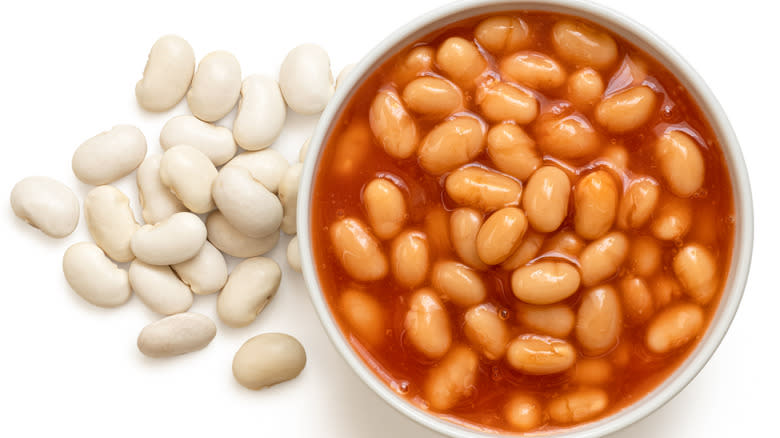
If you've been curious about the differences between canned beans and dried beans, you've come to the right place. There are advantages and disadvantages of both types of beans, so we're not able to point to just one and tell you that it's the best choice. Instead, you'll have to balance the pros and cons for yourself when fresh or frozen beans aren't available. That's why we've compiled a list of the different attributes of canned and dried beans so you can hopefully make a better choice for your needs.
There are a lot of qualities to consider when you're making your choice. The cheapest option is also the most flavorful option. However, it's not the easiest and fastest to make. Some of the other points to consider include texture, the potential for making you gassy, added preservatives, possible contaminants, along with some other attributes. Finally, we've provided an overview of the pros and cons of each type to make it a little easier to see the whole picture when you decide which one you should buy.
Read more: 16 Little-Known Facts About Salt
Dried Beans Take Longer Prep And Cooking Times
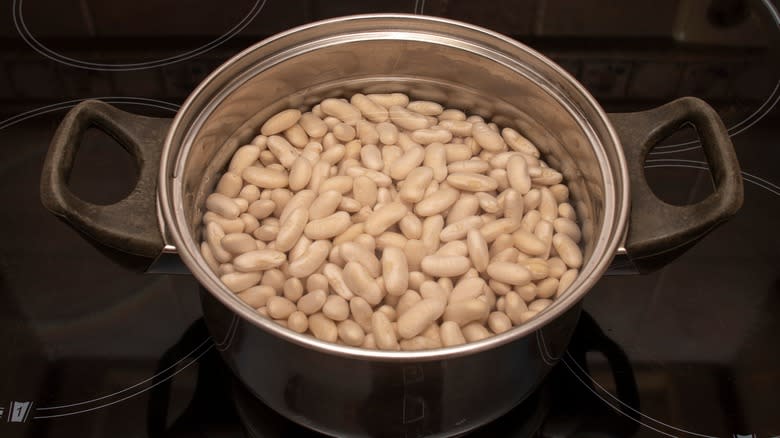
If you're looking for beans that you can cook quickly, canned beans are the answer. Canned beans come pre-cooked and simply need to be warmed, while dried beans often require soaking and a long cooking times to become soft enough to eat.
The reason it takes so long for dried beans to cook is because the tough outside of the bean takes a while to hydrate, which means that the only way water can get inside the bean at first is through the hilum (the dot in the curved valley of a bean). The amount of time a bean needs to soak depends on its type. Lentils and split peas need no soaking. On the lower end, black-eyed peas have thinner skins and only need 60 to 90 minutes of soaking, while some thicker-skinned beans like lima beans need eight to 12 hours of soaking.
There are a few ways to speed up the cooking time for dried beans. Pre-soaking thick-skinned beans, adding salt (3 teaspoons per quart of water), and adding baking soda (1 teaspoon per quart) can all decrease dried bean cooking times. If you pressure cook your beans, you don't need to do any of the above-mentioned methods to soften them quickly. Rather than taking 45 minutes to 2 hours of cooking time, using a pressure cooker (like an instant pot) only takes 15 to 35 minutes to cook dried beans without soaking (depending on the type of bean).
Dried Beans Are Cheaper
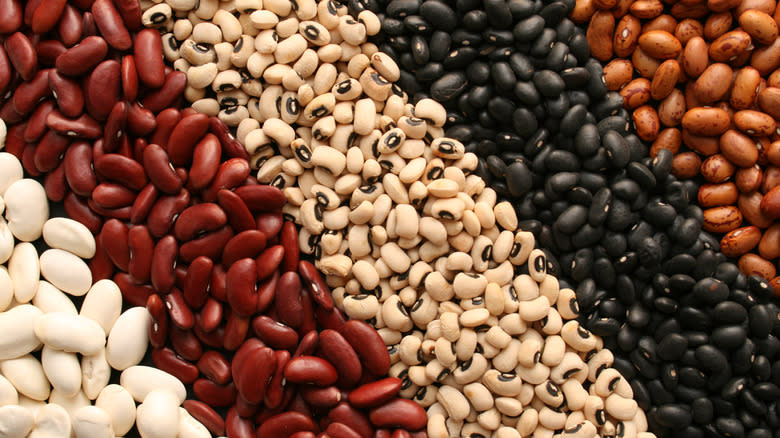
Even though it takes more time to make them, dried beans are cheaper than canned beans. Whether you buy them in bags or in bulk, the dried versions are still much more economical than the canned ones.
Since dried beans aren't hydrated and weigh less than hydrated canned beans, you have to look at the cost per serving rather than the cost per ounce. The cheapest pinto beans at our local Walmart is canned Great Value Pinto Beans, which costs $0.86 total or $0.25 per ½-cup serving. Meanwhile, a bag of dried Great Value Pinto Beans costs $1.98, and a single serving costs slightly less than $0.08. Yes, the serving for the dried beans is a ¼ of a cup, but they will plump up into a larger volume once they've cooked. All told, the canned beans cost $0.17 more per serving than the dried ones.
At first glance, dried beans look more expensive because of the total price of the product. However, you're getting more servings from a bag of dried ones than from a single can. In the case of the pinto beans we looked at, the can of beans contained 3.5 servings, while the bag of beans contained a whopping 26 servings. So, the dried ones save space in your cupboard as well.
Canned Beans Often Have Sodium As A Preservative
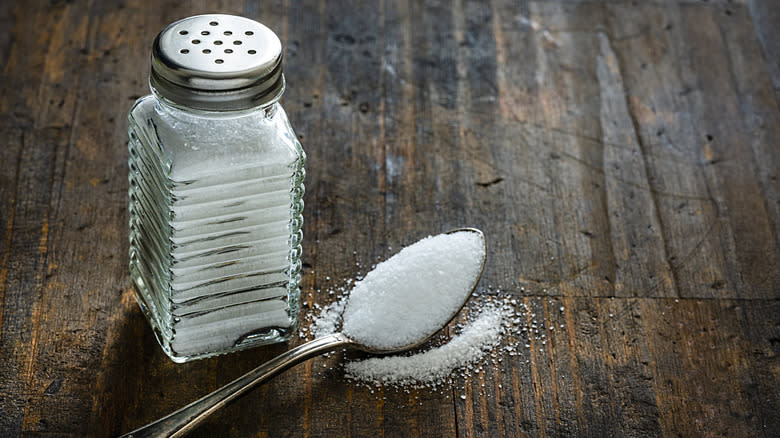
Any time you choose a canned product over one that you make from scratch yourself, it's worthwhile to look at the ingredient and nutrition list because there may be more salt or other sodium sources than you think. Salt is not only a preservative, but it makes the beans taste good straight out of the can, which could sway your decision about whether to buy the same brand again or not.
We looked again at the same Great Value Pinto Beans that we used for price comparisons to do some sodium comparisons. The canned version has 130 milligrams of sodium per serving (6% of the daily value) from salt and disodium EDTA, while the dried version has no sodium at all. The sodium amount isn't all that high in the can we looked at, but cans from other brands may have up to 25% of the amount of sodium you need for a day. So, it's still worth noticing to avoid going over your sodium intake needs for the day.
There is a trick to help decrease the amount of salt in a can of beans. Simply discard the soaking liquid and rinse the beans before using. Monica Reinagel, MS, LDN, told Allrecipes that draining the liquid can "reduce the sodium by a third," while draining and rinsing reduces it by 40%.
Dried Beans Can Benefit From Adding Salt

Since dried beans come with no salt added, you're probably going to want to add extra salt to them to enhance their flavor. Meanwhile, canned beans tend to come pre-salted, so you may want to taste them before you start salting them.
There are a few reasons for considering adding salt to dried beans. One reason you might want to add salt is that it helps to soften beans by weakening the pectin in their cell walls, which will help the beans to get soft faster. In fact, salt can cut your cooking time down by 20%, which means that if it would take normally take an hour to cook your particular type of beans, adding salt could take the cooking time down to 40 minutes.
Something you may have never considered, too, is salt's effects on bean skins. One trick for softer beans is to add salt to your soaking water to brine the beans before cooking. When your beans soak in salt water, their outer skins become softer, which will make your cooked beans that much softer both inside and outside. Other benefits of salting beans during the cooking process are that they get more plump and get fewer skins split while they are softening.
You're More Likely To Be Exposed To Unwanted Chemicals In Can Lining
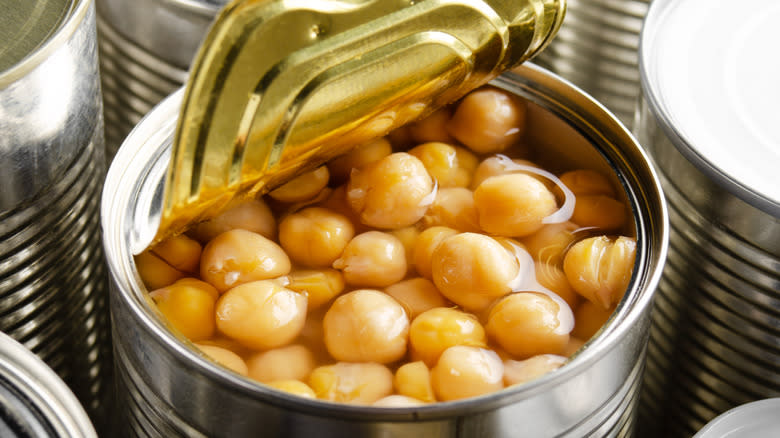
The chemicals that could be present in the can itself are concerning. If a can of beans uses a potentially dangerous chemical in the lining, it can potentially leech into the food you plan to eat that's inside the can. The main chemical to be concerned about is bisphenol A (BPA), which sometimes shows up in the lining of cans that forms a barrier between the metal of the can and your food. Luckily, not all cans are lined with BPA because many food companies in the U.S. have been moving toward removing BPA from their product containers.
So, what's the big deal about BPA? Well, a lot of studies over many years have pointed to it as a possible cause of several health problems. According to the Mayo Clinic, various studies suggest "possible health effects on the brain and prostate gland of fetuses, infants, and children. It can also affect children's behavior. Additional research suggests a possible link between BPA and increased blood pressure, type 2 diabetes and cardiovascular disease." While you shouldn't worry about it in low levels, it's best to choose canned beans from companies that don't use BPA in their linings.
You Can Cook Dried Beans To The Doneness Level You Desire
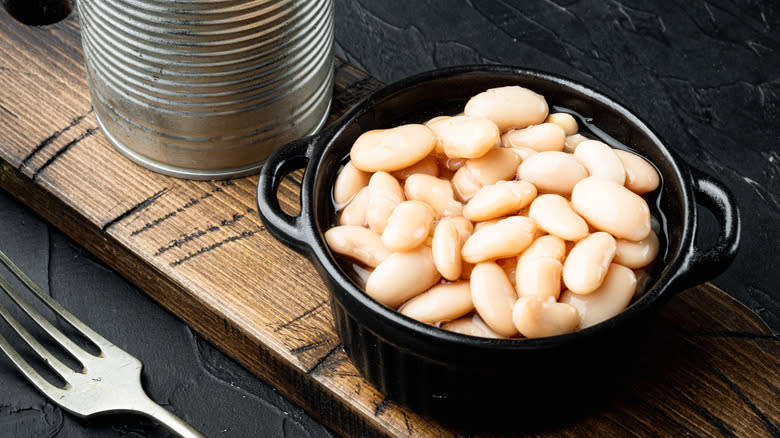
When you open up a can of beans to eat, you're stuck with the softness level the company cooked them to unless you cook them longer to make them even softer. However, with dried beans, you have a lot more control over whether they're firm, medium, soft, or even mushy.
One example that we've noticed is that when we use canned chickpeas to make hummus, the hummus is never as smooth as the type we find pre-packaged in stores or in restaurants. It's always a lot more chunky in texture whether we use the blender or food processor. If we use dried beans instead, we can cook them longer to get them softer.
If you look at cooking charts for beans, you'll notice that many have a time range for how long it takes them to get done. Extending that cooking end time an extra 10 to 30 minutes can take you from a firmer bean to a softer bean, depending on what you want. You're completely in control.
You Have Control Over The Texture With Dried Beans
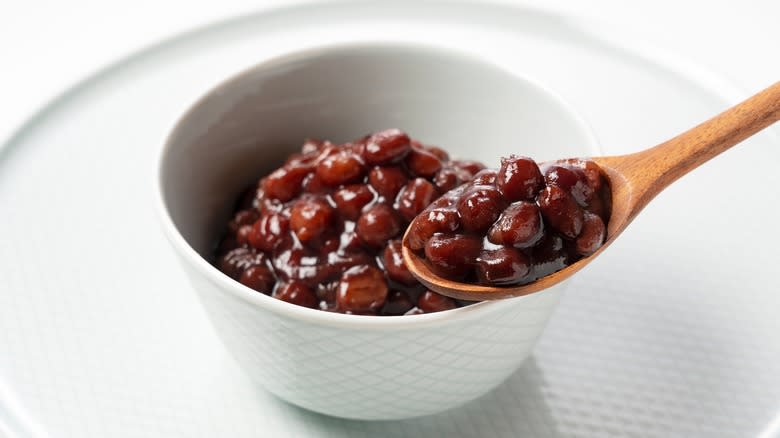
The texture of dried beans is different mainly because you can control cooking time and what you can do to the beans. Whereas, when you buy canned beans, you have to take whatever texture the manufacturing company gives you. It's also impossible to know what the texture is like before you open the can since you can't see into them on the shelf.
Chef and restaurateur Mike Solomonov told HuffPost that his restaurants all use dried chickpeas to make their hummus because it allows "more control of the cooking time" to get them softer. Plus, it allows them to do an overnight soak in baking soda. He explained that baking soda "lowers the boiling point and it makes the skins extra soft, which makes our hummus incredibly smooth. The baking soda in both soaking and cooking water turns the water alkaline, which helps break down the beans."
In actuality, there are three techniques that can help achieve plumper, creamier beans. Interestingly enough, they're the same techniques for cooking beans faster. Soaking them in water provides some assistance, and brining them in salt water before cooking makes them even more plump and creamy. However, soaking them in baking soda water provides even better results. If you combine all three techniques by soaking in water, salt, and baking soda, you get the creamiest beans.
Dried Beans Often Taste Better
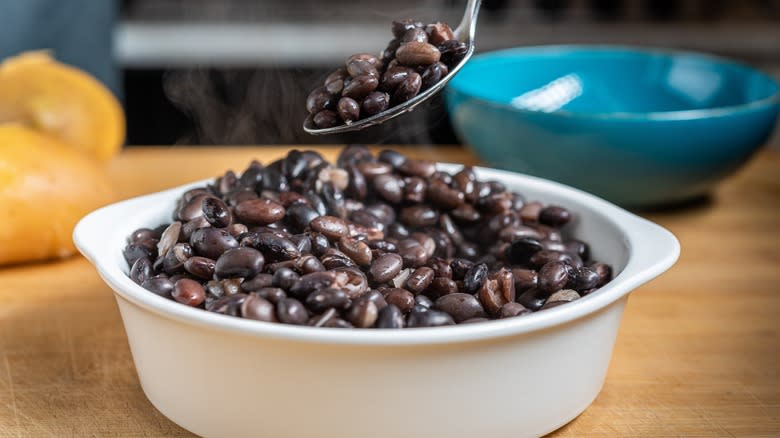
If the flavor of your beans matter, you're probably going to want to choose dried beans. While we've found them to not always be exactly like the fresh or frozen version of beans, the flavor is very often better than canned.
Sometimes, getting the canned version of beans can be off-putting. For example, we find canned chickpeas to often have a fishy flavor, which is why they're often a tuna fish substitute in vegan tuna salad recipes. Canned butter beans also tend to taste nothing like fresh ones or even dried ones, which is why we always urge people trying them for the first time to stay away from the canned version. Another type of bean that tastes better from dried is black beans, which are far more flavorful. However, some, like kidney and pinto beans, aren't all that different either way you buy them.
Something else that using dried beans allows you to do is to infuse your beans with the flavors you want while they're cooking. You can season canned beans that are already cooked, but they'll never taste as good and complex as when you cook the seasonings with them.
Canned Beans May Contain Added Nitrates Or Nitrites
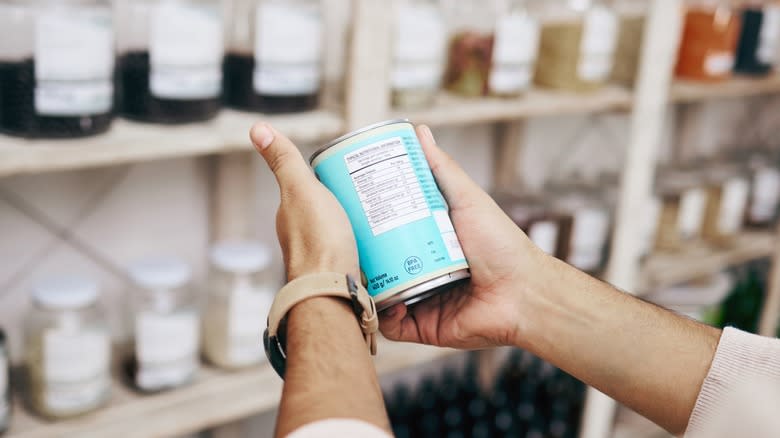
There are three reasons why canned beans may contain nitrates or nitrites. Some of them are natural, some of them are purposeful, while others are accidental. While nitrates and nitrates in food can be naturally occurring, it's also possible that the beans could collect nitrate or nitrite contamination from fertilizer while they're still in the field. So, these possibilities would be just as likely in canned as dried versions. However, some companies also use nitrates and nitrates as preservatives and for flavor in canned foods. You may want to label-read if you're concerned about having them in your food.
What's the big deal about nitrates and nitrites? Well, when nitrates or nitrates in food endure high temperatures (like high-heat cooking) or react with stomach acids, they have the potential for forming nitrosamines. Some nitrosamines can be carcinogenic. Kate Allen of the World Cancer Research Fund told the BBC that, "It's not so much nitrates/nitrites per se [that are carcinogenic], but the way they are cooked and their local environment that is an important factor. For example, nitrites in processed meats are in close proximity to proteins (specifically amino acids). When cooked at high temperatures this allows them to more easily form nitrosamines, the cancer-causing compound." Even if beans don't have nitrosamines naturally, having nitrates or nitrates added as preservatives could be an issue. So, you may want to opt for canned beans without them to err on the side of caution.
Canned Beans May Be Contaminated With Heavy Metals
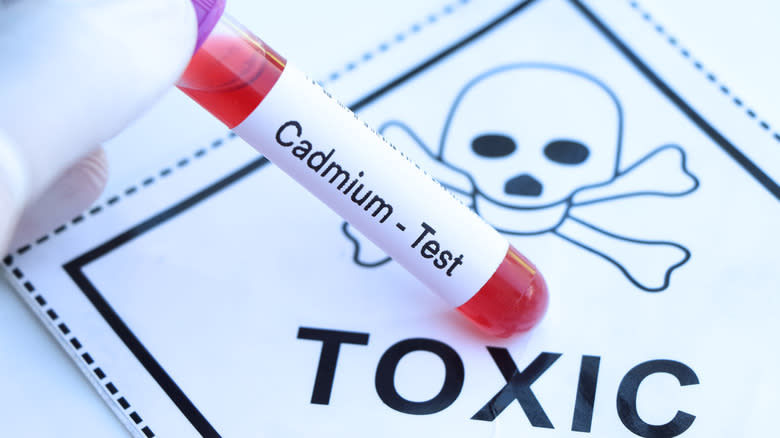
You don't have to be worried about heavy metal contamination with every can of beans. However, there are still risks for heavy metal contaminants, especially if they come from certain countries.
While the FDA in the U.S. tests food to make sure they're safe from heavy metals, foods that come from other countries may not come with that guarantee from a similar health organization. For example, a 2020 study by Toxicological Research found toxic and potentially unhealthy levels of cadmium in some Nigerian canned beans. There's no indication in the report as to how the cadmium got into the beans, but it could have been as simple as having been packed with contaminated water or having grown in contaminated soil.
Before buying beans from a country other than the U.S., it's worthwhile to note what type of food regulations a country has concerning its canned products or what type of food product reputation it has before consuming them. If the regulations are lax or non-existent, you might want to think twice about eating beans made and packaged in that country.
They Need Rinsing For Different Reasons
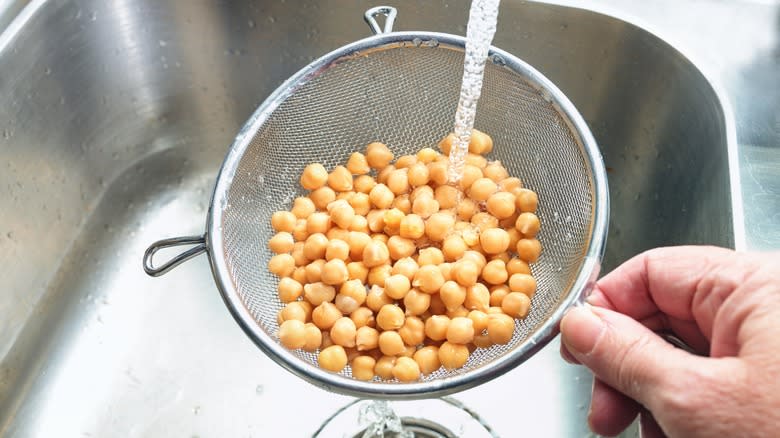
Because they're processed and packaged differently, there are different reasons you might want to rinse canned vs. dried beans. However, there's a shared reason, too. There are two reasons for rinsing beans that differ based on how they're packaged. When it comes to dried beans, there's always the chance they could have been accidentally packaged with rocks, dirt, debris, or damaged beans. So, rinsing and looking closely for foreign matter is always a good idea. We've already mentioned one of the reasons for rinsing canned beans: rinsing can help remove sodium-laden water if it's of concern to you.
There's another reason to rinse beans that you may have already heard about. That is, rinsing cooked beans can help prevent you from becoming as gassy after you eat them. This advice is true whether they come pre-cooked in a can or you cook them yourself. Of course, rinsing them also removes a lot of the flavors in the bean and removes its cooking liquid, so you have to balance the lower gas benefits against the flavor loss disadvantages.
Canned Beans May Be Less Likely To Make You Gassy

Speaking of beans and flatulence, you're more likely to be gassy if you eat dried than canned beans. Luckily, there are some ways to reduce gassiness from beans. When Serious Eats tested canned beans against dried beans, it found that canned beans caused about 20% less gas than dried ones. So, if you are making your decision on dried vs. canned and will be around people, canned may be the way to go.
There are a few ways to reduce how gassy beans make you, whether they're canned or dried. Serious Eats' tests found that rinsing beans also resulted in 20% less gas than unrinsed. However, it didn't find any special cooking or soaking techniques that reduced gassiness. There are a few other methods that some people swear by for reducing gas that may or may not work, like using a pressure cooker, adding baking soda to the soaking or cooking water, or adding spices like ajwain or epazote (both of which people use to relieve general gas symptoms).
How To Decide Which Type Of Beans To Buy
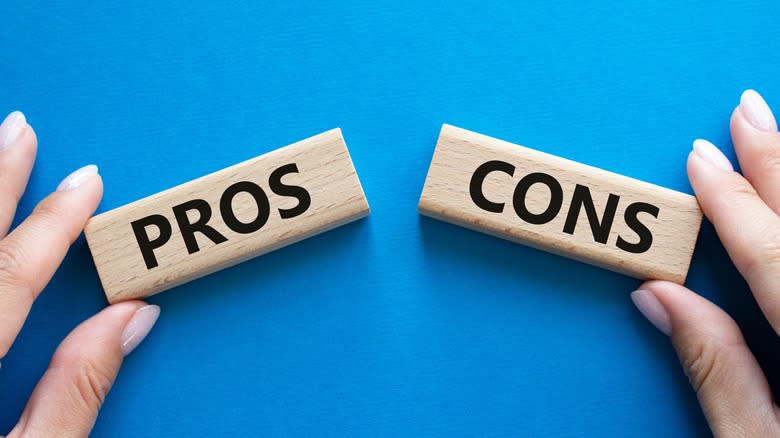
As you can see, there are pros and cons to both canned and dried beans. So, deciding which to buy depends on which attributes are more important to you. The question is whether price, convenience, flavor, texture ingredients, or possible health risks will win out when you make your choice.
The advantages to dried beans outweigh the disadvantages. The advantages include that they're less expensive and have a better texture and taste. You have control over any added ingredients to keep them healthier, safer, and tastier. Plus, you can control the softness level. However, there are still two negatives: they require more time and forethought for prep and cooking and are likely to make you more gassy.
Meanwhile, there are more disadvantages to canned beans than advantages. The good thing about canned beans is that there's less prep and cooking involved, and that they're less likely to make you gassy. Unfortunately, there are a lot of potential negatives. There's usually added sodium and sometimes other added preservatives as well. They're more expensive, you have no control over texture, and the flavor often isn't as good. There's also the risk of heavy metal exposure if they come from a country with lax food laws.
Read the original article on Mashed.

 Yahoo Lifestyle
Yahoo Lifestyle 
